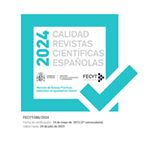América y utopía en el siglo XVI
Abstract
Represented as the New World for antonomasia, the appearence of America have arisen important questions about the world and its physical and mental representations. So lost of new interpretations sprang in the european social imaginary. America not only meant the discovery of new lands, but also the discovery of a new humanit. The New World imposed itself also in prornoting the conscience of a new chronological dimension. As Thomas More demonstrated in 1516 in his famous De optimo Reipubliccae statu, deque nova insula Utopia, important questions about european civilization values and laws were advanced: at the same at time that Europe was deeply crossed by many troubles and reform aspiration, America became the physical place where the Utopia could be realised. if we examine the different points of view, from Vasco de Quiroga‘s project to reform socially and institutionally, the native communities (disrupted by the Conquista), to the Bartolomé de Las Casas aspiraton of a «universal reforrn of lndias” and to the mexican Franciscans political and social utopia, we obtain the texture of an alternative project. In this project the reminiscence of the primitive Christian communities, was still present, with some erasmian and millenaristic influence, giving an utopic representation of a radically different society. A particular meaning has the «utopia andina», an indigenous project of a «space— time» of redemption from Spanish domination. the Utopia in America was characterised by its aspiration to be set in the reality. In this way, underling the difference of the New World, the Utopian projects contributed to the affirmation of the right of an equality that was not an assimilation and of a difference that was not un inferiority.Downloads
Article download
License
In order to support the global exchange of knowledge, the journal Cuadernos de Historia Moderna is allowing unrestricted access to its content as from its publication in this electronic edition, and as such it is an open-access journal. The originals published in this journal are the property of the Complutense University of Madrid and any reproduction thereof in full or in part must cite the source. All content is distributed under a Creative Commons Attribution 4.0 use and distribution licence (CC BY 4.0). This circumstance must be expressly stated in these terms where necessary. You can view the summary and the complete legal text of the licence.












